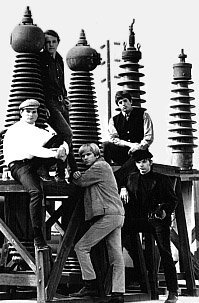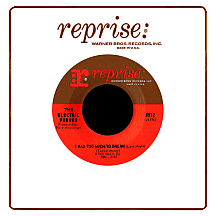THE ELECTRIC PRUNES
I Had Too Much to Dream
(Last Night)
In 1966, Los Angeles-based songwriter Annette Tucker was starting to have a little success (with Linda and Keith Colley, she composed "High on Love," impacting radio briefly that summer via a version by New Jersey group The Knickerbockers). Annette and Nancie Mantz (whose path as a songwriter had also crossed Colley's) outlined "I Had Too Much to Dream (Last Night)," depicting a passionate yet unfulfilled encounter ('You were so real that I could feel your eagerness...and when you raised your lips for me to kiss...came the dawn...and you were gone...'). These lyrics could have been rendered as a straight romantic pop song, but in the hands of producer Dave Hassinger, L.A. rockers The Electric Prunes transformed it into a psychedelic hallucination.
The Prunes had begun in L.A. suburb Woodland Hills around 1964 as a surf combo, first calling themselves The Sanctions and later Jim and the Lords (a faux-British camouflage reconsidered and abandoned). Rhythm guitarist and lead singer James Lowe, bassist and keyboard player Mark Tulin and lead guitarist Ken Williams formed the core of the group with Michael "Quint" Weakley as drummer; 16 songs, mostly earlier rock and roll standards, were recorded on acetates on two separate occasions in 1965. Random acquaintance Barbara Harris (given a nod as "Initial Spark" in the credits of the band's soon-to-be released first album) helped get them an audition with Reprise Records. Dave Hassinger's main claim to fame was his work engineering a number of recordings for The Rolling Stones, including their signature classic "(I Can't Get No) Satisfaction" and the entire Aftermath album, recorded in late '65 and early '66 at the RCA Studios in Hollywood, an experience that set him on a rock kick. The Prunes became his pet project.

The first single, "Ain't it Hard" (a cover of a song by L.A.'s Gypsy Trips), has a sound not unlike many British blues-rock recordings of a year or two earlier. The first of many lineup changes occurred around this time; Preston Ritter nabbed Quint's percussion spot and guitarist James Spagnola (credited only as "Weasel" on the album's notes) was added as a fifth member. "I Had Too Much to Dream" came near the end of 1966, its psych-rock flavor spiraling from Ken's use of a Bigsby Wiggle Stick (an accessory designed by motorcycle racer/guitar maker Paul Bigsby that, when connected to an electric guitar, creates a vibrato sound). The trippy single, its title suggesting drug use (thus adding to its legitimacy as a counter-culture rock song), got as high as number eleven on the Billboard singles chart in early '67. Annette Tucker and Nancie Mantz dominated the proceedings, composing six songs for the Electric Prunes' self-titled debut album with an additional two by Tucker and Jill Jones.
"Get Me to the World on Time," an appropriate follow-up single penned by Tucker and Jones, took the romance motif into more surreal territory ('This chemical reaction isn't easy to refine...you drive me to distraction, you disturb my peace of mind...Wild sensations! Sweet frustrations!') and returned the Prunes to the top 40 in April. "Dr. Do-Good," the Mance-Tucker leadoff single from the quickly-conceived second album, Underground, amped up the Bigsby effects for a more "mind-blowing" sound. Band members were given more opportunities to compose original material; a pair of Lowe-Tulin songs received a fair amount of airplay around the country, but failed to make a showing on any national charts. "The Great Banana Hoax," a solid psych rocker, avoided any mention the short-lived "banana peel smoking" fad of the time. "Everybody Knows You're Not in Love," taking a more conventional pop approach, is one of the band's stronger efforts.
Further lineup changes accelerated the group's disintegration, but Reprise and Hassinger, who owned the band's name and controlled its contract, didn't much care. Later recordings such as "Shadows" (penned by Michael Z. Gordon and Stu Phillips), a contribution to the soundtrack of a shock-tastic low-budget 1968 cult film, The Name of the Game is Kill starring Jack Lord (right before he took a permanent-'til-retirement gig as Steve "Book 'em, Danno" McGarrett on TV's Hawaii Five-O), could have included contributions from any number of musicians. Third album Mass in F Minor had little, if any, input from original E-Prunes dudes. David A. Axelrod, who was mainly known for his jazz productions, composed all the material (one track, the chanting monklike "Kyrie Eleison," showed up the following year on the soundtrack of the wildly popular and trendsetting Easy Rider). Fourth longplay Release of an Oath - The Kol Nidre was another Axelrod production. 1969's Just Good Old Rock and Roll, despite its title, was not a collection of early rock songs. The Electric Prunes no longer existed except in name; Kenny Loggins, who'd made his first records as a member of The Second Helping, played guitar in one late lineup of the band during a 1969 tour featuring mostly non-Prunes tunes.


